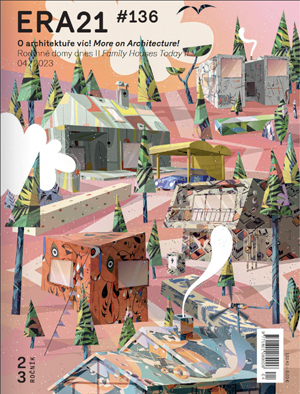The problematic relations of today’s professional and general public to architecture of the previous regime has previously been articulated on several occasions. It is reflected in cases associated with secondary interventions, transformations, and demolitions of architecture of that time, in artistic interventions as well as the latest expert research. Perhaps the greatest share of attention is given to the issue of prefab panel housing estates but other examples and realizations including interiors are next in line. The young generation of publicly active authors, often unburdened by personal experience with the pre-revolutionary regime and soberly reflecting the social-political and cultural situation after the revolution, can view this period objectively and assess it critically. Architecture and art of the socialist era is slowly attracting attention of experts and ceases to be invisible and a priori rejected. In many cases, it even serves as a starting point or inspiration for contemporary production.
» entire articleInstitut plánování a rozvoje hl. m. Prahy (IPR Praha) otevře ve svém sídle v areálu Emauzy nové Centrum architektury a městského plánování CAMP. Ačkoli oficiálně se CAMP otevře pro širokou veřejnost až v září, čtenáři časopisu ERA21 budou mít možnost nakouknout do nového prostoru již ve čtvrtek 25. května.
» entire articleThis unusual family house was built on a sloping site oriented to the north on the outskirts of Prague – in Kyje – overlooking the River Rokytka valley. The house reacts to the surrounding full-grown trees with its shape, character, and volume. The ground plan of the house is based on a circle that transforms into two squares on the southern side; the continuous three‑story space gets narrower towards the top of the house and ends with a skylight. The living room on the ground floor with a gallery oriented to the north thus receives sunlight from the south. The ground floor also houses a bedroom, kitchen and bathroom; another bedroom is available on the first floor, the gallery serves as a study room. The house is designed as a wooden structure with a reinforced concrete foundation that is limited to a stem in the steep slope. The wooden structure is acknowledged in the interior; the exterior is insulated with a polyurethane protective spray.
» entire articleNepřehlédnutelnými událostmi uplynulého měsíce se stala dvě souhlasná vyjádření – jedno stavební povolení pro bytový Obličejový dům v sousedství Anežského kláštera od architekta Zdeňka Fránka a opětovné územní rozhodnutí pro administrativně-komerční Květinový dům na Václavském náměstí z projekční kanceláře Chapman Taylor. Na první pohled dvě velmi podobná dramata o zasazení nové architektury do kontextu historické Prahy. Ale jen na první pohled.
» entire articleAll over Europe, and the world, there are institutions acting as architecture liaisons to the public, be it nationwide or just locally in regions and cities. Here, in the Czech Republic, we don’t have an institution that could be labeled as a center of Czech architecture. This task is being taken up by various activist organizations, however, they are struggling with financial, personal, or legal limits. This issue of ERA21 is focused on institutions integrated in the official state or local administration structure.
» entire article

ERA21 vydává ERA Média, s. r. o. |
|
|
Phone: +420 530 500 801 E-mail: redakce@era21.cz |
|
| WEBdesign Kangaroo group, a.s. |